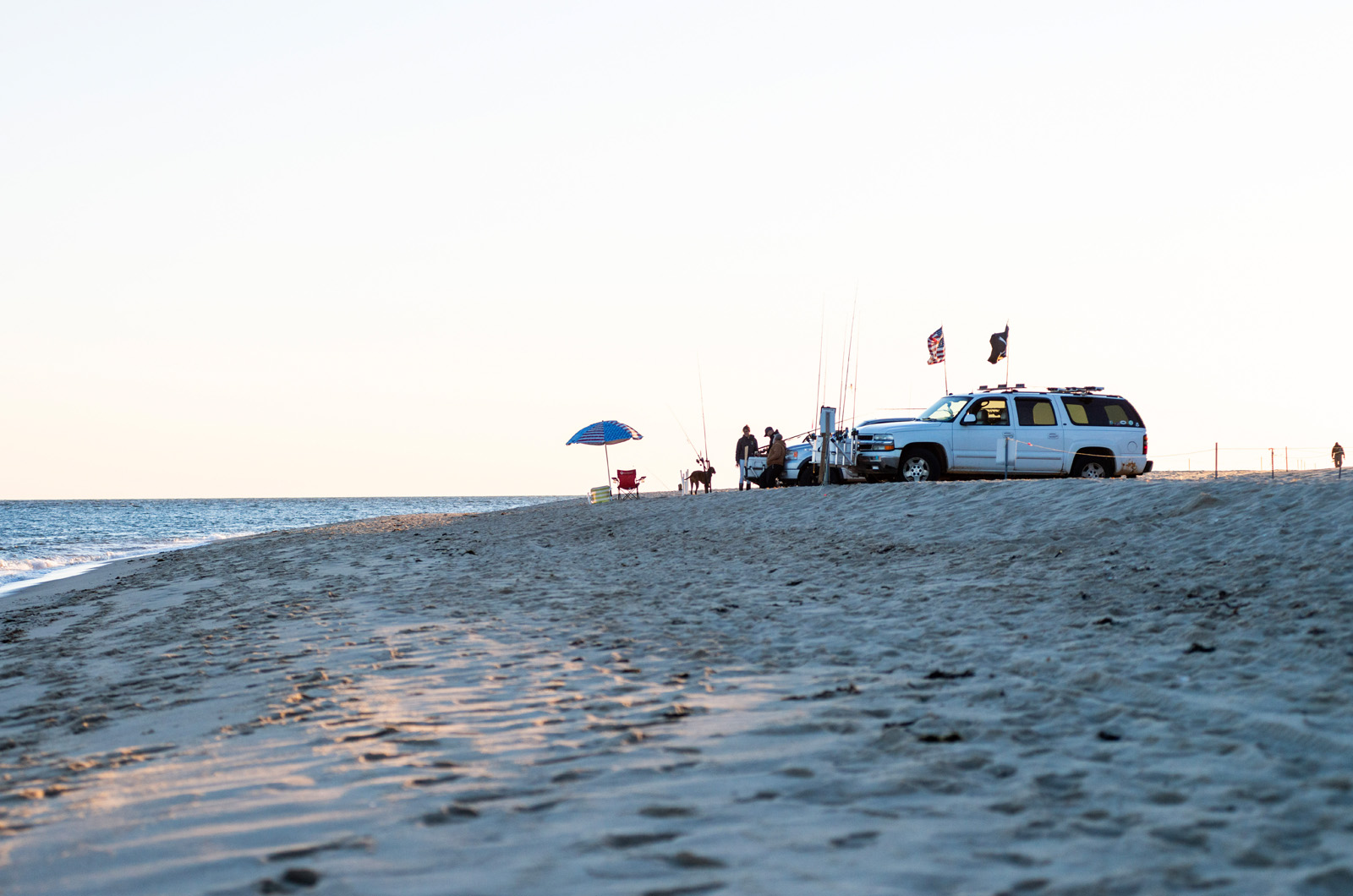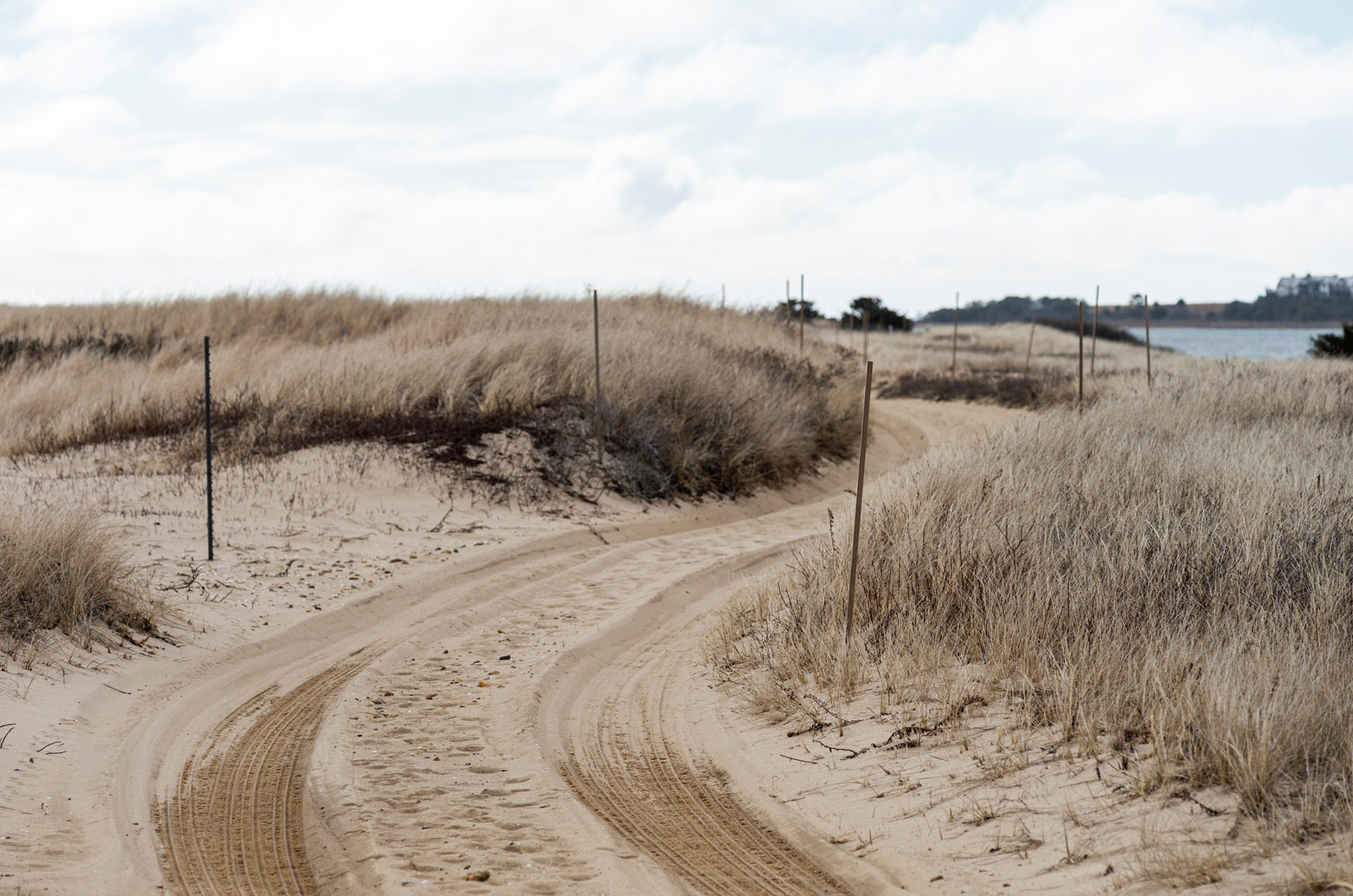Located on the furthest, most immaculate tip of Chappaquiddick, Cape Pogue Wildlife Refuge is home to salt marsh, coastal cedars, endangered shorebirds and some of the best recreational fishing the Vineyard has to offer. Save for a few scattered houses, the property is untouched by development, although withered by persistent winter storms and erosion.
In recent years, the beach has also become a battleground.
For decades, The Trustees of Reservations has sold oversand vehicle permits to access its Chappaquiddick properties on Leland Beach, Wasque Reservation and, until last year, Cape Pogue. In 2022, the statewide land nonprofit returned to the Edgartown conservation commission to renew its program for the first time in more than 30 years. Nearly two years later, the two parties are nowhere closer to a consensus, and the road forward has only gotten bumpier as town officials, abutting residents and recreational beachgoers all spar over who can drive over the dwindling barrier beach.
Recently, the debate has become personal. In a conservation commission hearing Wednesday, Cape Pogue resident Rachel Self, who has long sought to limit OSV access near her property, said she has received hate mail and threats to her safety from OSV advocates. Earlier this month, Ms. Self filed an application to allow five fishermen to access her property during the Martha’s Vineyard Striped Bass and Bluefish Derby. The move has been criticized as impractical and disingenuous by Derby fishermen looking to restore wider public access.
Last month, the dispute hit another speed bump when the Edgartown planning board realized that the 1990 special permit that originally determined OSV access was nowhere to be found.
“To date I don’t know if we’ve seen a copy of the final approval by the planning board,” planning board member Doug Finn said in a recent meeting. “We can’t find the special permit itself.”
What the board does know is the permit was approved on condition that the program undergo an annual review to reconsider management practices. In the 30-plus years since, there’s no evidence any such review took place. The issue now goes to town counsel, who has been asked to determine whether the Trustees will need to start over their OSV application from scratch.
Talking to both abutters and OSV users today, each side seems to recall a bygone era when consensus came more easily and the Island community came together more readily. Vehicles have driven out to Chappy since the post-World War II era, predating the Trustees’ management. Until recently, Ms. Self said her family had peacefully coexisted with the Trustees for decades; her grandfather originally donated land at Cape Pogue to the Trustees in the 1950s. Lisa Belcastro has fished on Chappaquiddick for more than 30 years and said tensions have only begun to flare up in the past several years.
What documents remain surrounding the 1990 beach management plan and its approval seem to uphold this rosier view of days past. The plan itself is comprehensive and includes detailed financial plans, a professional land survey, a human impact survey and other environmental data. On its final page, it bears the signatures of surfcasters, shellfishermen, Chappy property owners, and conservationists alike.
Tom Chase remembers things differently. Having worked as an ecologist for the Trustees from 1985 to 1994, Mr. Chase said today’s debates are just a new manifestation of the same problems that have confronted the Trustees for decades, even though the official documentation may paint a more harmonious picture.
The early 1990s were a time when the state and federal government began to take a harder look at ecological conservation, particularly regarding endangered shorebirds that inhabit Chappaquiddick and other parts of the Cape and Islands. Piping plovers, in particular, were known to nest in the coastal dunes and had the inconvenient habit of nesting in the deep tire tracks left behind by oversand vehicles. In 1993, the state mandated OSV trail closures during shorebird nesting season in an attempt to save the diminutive birds from the brink.
Since then, OSV users and conservationists have found themselves in different camps, Mr. Chase said.
As a land manager whose conservation budget is supplemented by OSV permit sales, the Trustees are somewhat straddled between those two camps. Last year, the Trustees sold 1,531 OSV permits for its Chappaquiddick properties bringing in an estimated $336,000 in revenue. Even so, the Trustees have reported operating at a deficit of $300,000 on Chappaquiddick, which it covers with a mix of state funding and philanthropic support.
“There’s no better way to sow discord in a community than to make two groups who formerly trusted each other not trust each other,” Mr. Chase said.
That discord often played out directly on the pristine shores of Chappy. In 1992, Mr. Chase hired biologist Luanne Johnson to oversee endangered shorebird monitoring on Chappaquiddick. The following summer was the first summer the state mandated OSV beach closures to protect piping plover nests, and Ms. Johnson was the person in charge of enforcing those closures.
“People screamed and yelled at me,” she said. “They’d yell at me on the Chappy Ferry and I’d roll my window up in their face.”
“’Piping plover tastes like chicken’ was a popular bumper sticker around that time,” she added.
After three years, Ms. Johnson said she eventually left the Trustees because she could not handle the ideological strain between conservation and recreation. But even in the face of such vehement backlash, Ms. Johnson said she always felt supported by Trustees leadership at the time, support she said has waned over time.
“In my conversations with current shorebird staff . . . I hear that their lives are much more contentious within the organization than when I was a shorebird person,” she said.
Ms. Johnson added that she believed the current Islands director, Darci Schofield, has worked harder to bridge that gap.
Former Trustees Islands director Chris Kennedy also attributes today’s apparent breakdown to a change in leadership. For more than 30 years, Mr. Kennedy ran operations on Chappaquiddick before his retirement in 2020, providing the final sign-off on the 1990 beach management plan.
In the past five years, he said, most of the organizations’ longtime employees have left or retired, leaving little institutional memory intact. Recently, the Trustees have also encountered wider structural problems. In 2022, former CEO John Judge stepped down after just eight months on the job. Earlier this year, the organization laid off 10 per cent of its staff, including one Vineyard employee, due to “ongoing multi-million-dollar structural deficit.”
The personnel shakeup has in turn hurt the organization’s relationship with the Vineyard community, Mr. Kennedy said.
“We really did work overtime building a relationship with our neighbors,” he said. “That clearly doesn’t exist right now.”
That’s not all that has changed. When Mr. Kennedy served as Islands director during the first Dike bridge replacement in 1993, he was a vocal advocate for limiting OSV access on Chappaquiddick, claiming the delicate beach could not handle increased traffic from a vehicle bridge. Edgartown, on the other hand, supported unfettered vehicle access, not wanting to invest in a “bridge to nowhere.”
The town ended up winning out. In 1995, the newly rebuilt Dike Bridge opened to vehicles and pedestrians, eventually becoming the main access point to the Trustees’ Chappaquiddick beaches.
Today Mr. Kennedy’s public position has all but reversed. In conservation commission hearings, he is a frequent spokesman for the Martha’s Vineyard Beach Access Group (MVBAG), an organization dedicated to maintaining historic OSV access to Cape Pogue and other Chappaquiddick properties.
When asked why his position had evolved, Mr. Kennedy pointed to a study on Plymouth
Beach in Plymouth that determined OSV use had negligible impacts on coastal beach compared to natural tides and storm events. He also said OSV activity today is less than what it was in the 1990s.
“The perception may be that there are more vehicles out there, but in reality there really aren’t,” he said.
But according to the Trustees’ data, OSV use has, in fact, increased. In 1993, Mr. Kennedy reported 17,000 vehicle trips per year on its Chappaquiddick properties even before the Dike Bridge had been rebuilt. In 2023, however, the Trustees’ traffic counter at Dike Bridge reported over 25,000 trips.
The barrier beaches themselves, meanwhile, have only diminished in that time. The Trustees’ property on Wasque alone has shrunk from 200 acres to just over 160 in the past 30 years, with the bulk of that erosion taking place in the past 15 years, Mr. Kennedy said.
Town officials have raised concerns about how OSV activity at its current levels might affect the natural resource. Unlike the 1990 plan, the 2024 beach management plan does not contain any human impact studies or even a detailed financial plan of how the land trust will maintain its coastal properties. In emails to the Gazette, Trustees spokeswoman Mary Dettloff confirmed that the Trustees have not conducted a human impact study for the area since 1990, although there are references to the negative impacts of humans and OSV use in their 2004 beach management plan.
“Based on The Trustees’ long history of ecological scientists and professionals, a human impact study likely won’t tell us anything we don’t already observe or expect in our management of the Chappaquiddick beaches,” Ms. Dettloff said.
As the Trustees continue through the contentious, often-gridlocked review process, the priority stakeholders all seem to share is to preserve the unique character of Chappaquiddick for future generations to enjoy. Whether that future involves bikes, sand wheelchairs, or shuttles remains to be seen.
“I don’t know any fisherman that doesn’t want to preserve Chappy,” Ms. Belcastro said. “We want our kids to be able to fish out there, our grandkids to be able to fish out there.”
“It’s just that special.”






